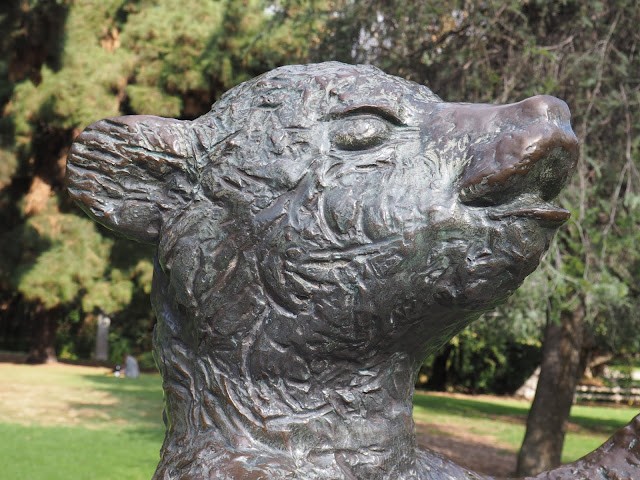I’ve been walking, and thinking about obelisks. If you walk a couple of miles, all of them up hill, from where I am now in East Hollywood, you’ll come to the Griffith Park Observatory, and outside it you’ll find this:
It’s sometimes known as the Griffith Observatory Obelisk, sometimes as the Astronomers' Monument, designed by Archibald Garner, completed in 1934 even before the opening of the observatory, about 40 feet tall, with figures of Hipparchus, Copernicus, Galileo, Kepler, Newton, and Herschel at the base. (I admit that I’d never heard of Hipparchus.)
Those statues and the armillary sphere on top give it a rather more complex design than I think an obelisk should have, though I’m not knocking it. But if you head down the road to the Hollywood Forever Cemetery you’ll find (what seem to me at a least) purer examples of the breed, such as this one marking the grave of Griffith J, Griffith, the very man that Griffith Park is named after.
Further south still, on the University of Southern California campus, you’ll find a line of comparatively short obelisks, each about nine feet tall, which mark the involvement of students and faculty in the 1984 Los Angeles Olympics.
So clearly Los Angeles has its shared of obelisks even if it’s not exactly famous for them. London on the other hand, has loads, as I found out recently.
The "biggie" of course is Cleopatra’s Needle on the Embankment (above), a genuine Egyptian obelisk, and that’s a whole obsession in itself, especially how they got it to England: in an iron tube that was 90 feet long – the obelisk itself being about 70 – and they built an ocean-going vessel around it so it could towed all the way from Egypt. Complications, some of them lethal, ensued.
I didn’t know any of this story until very recently, and asking around my acquaintances, many of whom like to think they’re pretty knowledgeable, none of them did either.
Once you start keeping your eyes open for obelisks, London seems to be full of them, and again some look more perfect examples than others. I saw obelisks in Chelsea:
West Hampstead:
Saville Row:
In an antique shop in Mayfair
In Bunhill Fields, an obelisk monument to Daniel Defoe, but Iain Sinclair has claimed Bunhill Fields so fervently I dare hardly set foot there.
And outside of London too, such as this rather wonderful one in Mistley, in Essex. Those are the Mistley Towers behind it, and there’s an inscription on the obelisk commemorating a local woman named Jane Death. I kid you not.
I also realized that I’d photographed obelisks in the past, while out walking, without really thinking about it much. This one in Bristol:
There is also this especially fine obelisk on a crazy golf course in Great Yarmouth.
And I know that years ago I was in Washington DC and definitely saw the Washington Monument. This is the tallest obelisk in the world, 555 feet high, completed in 1844 – there is much discussion about whether or not slave labor was used. In any case, I only saw it from a distance, and I was young and unimpressionable back then. There is also an argument that it isn’t a true obelisk, which should be made from one piece of stone – impossible given the size, and also given that there is currently an elevator inside.
And I know that years ago I was in Washington DC and definitely saw the Washington Monument. This is the tallest obelisk in the world, 555 feet high, completed in 1844 – there is much discussion about whether or not slave labor was used. In any case, I only saw it from a distance, and I was young and unimpressionable back then. There is also an argument that it isn’t a true obelisk, which should be made from one piece of stone – impossible given the size, and also given that there is currently an elevator inside.
And if you’re a conspiracy theorist you’ll be thrilled to see this:
And finally (at least for now, I mean this obsession is only just starting, I haven’t even started on Athanasius Kircher) there is this by the great illustrator Tom Gauld.
It’s a myriorama “inspired by the works of Laurence Sterne, and I’m actually not sure If that walking figure is Sterne or Tristan Shandy, but that’s very definitely an obelisk. Now, there is no mention of an obelisk in Tristram Shandythough there’s plenty of walking, nor is there an obelisk mentioned in A Sentimental Journey,so this may be an indication of Mr. Gould’s own obelisk obsession.
I have, however found a reference to an obelisk in Sterne’s writing. It appears in Sermon XVIII titled “The Levite and his Concubine” and runs as follows:
“Certainly there is a difference between Bitterness and Saltness, that is, between the malignity and the festivity of wit, the one is a mere quickness of apprehension, void of humanity, and is a talent of the devil; the other comes from the Father of spirits, so pure and abstracted from persons, that willingly it hurts no man : or if it touches upon an indecorum, 'tis with that dexterity of true genius, which enables him rather to give a new colour to the absurdity, and let it pass. He may smile at the shape of the obelisk raised to another's fame, but the malignant wit will level it at once with the ground, and build his own upon the ruins of it.”
Wit, obelisks, ruins – my kind of sermon.


















































